The Two Rivers Park – by Franci
We always love visiting Zoos and Parks. We enjoy seeing animals that we have never seen before. : ).
The Two Rivers Park has a big, open area of green fields and a pond, but all the actual enclosures are located in the adjacent forest. Its almost as if you were walking on a path in the woods and there just happen to be wire between you and a whole lot of cool animals. Okay, maybe not quite, but really close : ).
I was happy to see the pond, because up until now I haven’t been able to just stop and look at the water fowl. (I usually just manage to see the birds as dark spots on the water before the car zips past). The birds on the pond were mostly Mallards (Anas platyrhynchos) with a few Canada Geese grazing next to the water. Mallards are the brown ducks with green heads that are usually drawn in children’s books and overall portrayed as the ‘stereotype duck’. After spending some time on the North American continent, I can understand why. They are always around when there is a body of water! Here’s a fun fact about ducks: If you look close enough at the beak you can see a ‘wolf’ posing as the bird’s beak. I’ll give you a tip: the duck’s nostrils are the wolf’s eyes. Now next time you see a duck try to see if you can find its hidden wolf ; ).
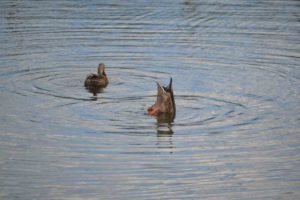
Ducks look so funny when they feed. Their heads disappear under the water, with their tails left to wag at the sky. They really have to kick very hard to stay upside down like that, as their feathers are filled with air and they bop back up as soon as they stop kicking. If you look at underwater footage of them you can see that the ducks themselves seem quite comfortable, but they look soooo ridiculous. They swim in the complete opposite way compared to Puffins. Puffins use only their wings, but Ducks and Geese use only their feet. Ever wonder why a duck waddles? Because their feet are situated farther back on their bodies, enabling them to swim very effectively, but impeding their walk so that they waddle. It’s even more so with Penguins.
*Ahem*, anyway. I already wrote a bird blog. So, on with the day. We had a great picnic at a table before entering the ‘animal part’ of the park. We were carefully watched during lunch by a rather jumpy red squirrel. It tried al sorts of ways to get closer without us noticing. It tried to get above us onto the little wooden roof, decided that wouldn’t work and then tried to sneak through the small plants just next to us. Sophia kept a vigilant eye and made sure the squirrel didn’t come close.
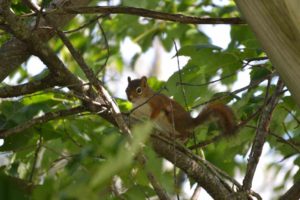
At the entrance to the park you can buy small packets of interesting plant-based treats you can feed to some of the animals, especially the deer and caribou (moose). I was pleasantly surprised when my Dad bought four packets : ).
There are about 5 different large enclosures for the buck, each with its different kind of deer. These enclosures were so like the deer’s natural habitat with definite similarities to those forests we’d been driving past and hiking in. Main similarity being: We did not see any wildlife : /. There were lots of signs that the enclosures were actually inhabited by the advertised animals, like the numerous hoof prints running along the fence, but not much else. We did briefly glimpse the silhouette of a moose through the trees, though (all thanks to Sophia’s sharp eyes), but other than that our great hopes of seeing moose did not materialise : l We did see a whole bunch of God’s other amazing creatures, though : ).
The only deer enclosure in which we saw anything was the Reindeer one. We were just about to move past to the next animal when one solitary, big, male Reindeer came into the small wooden feeding house (each buck enclosure has one). We were thrilled and quickly proffered some of our treats in order to get him to stay. There’s a slit across the shed through which even a big horse would easily put its head, but because of its antlers the reindeer had to twist his head and even so only managed to get his head out a little way.
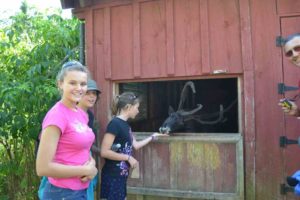
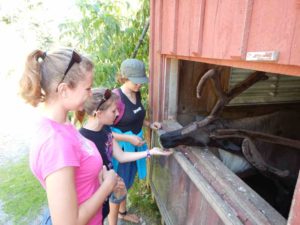
When we stopped offering treats he came out of the shed and stood next to the fence where we could see him better.
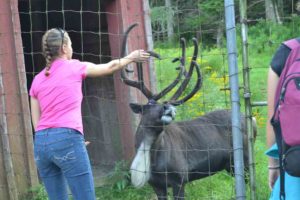
His antlers were huge! And they were covered in brown fuzz, which means they were still growing. Antlers are only bone, so when they grow, they need a layer of skin as protection. What I find really amazing is that these beasts regrow their antlers each year. When we walked past the enclosure again later, the Reindeer was still there, accepting treats from other admirers. One of the caretakers later told us they named him Rudolph, and he is the only one, out of all the bucks, that has cottoned on to the idea that treats are being handed out : P.
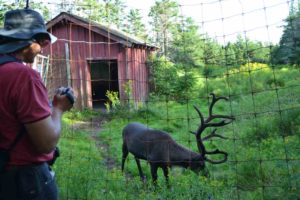
Along with Rudolph, the smartest and/or greediest Reindeer, we saw many other things. There were big white Artic Wolves and Coyotes (one of which had a very direct stare of icy blue out of a dark face).
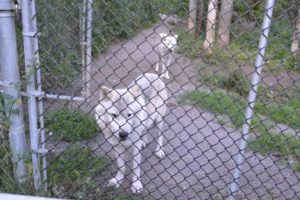
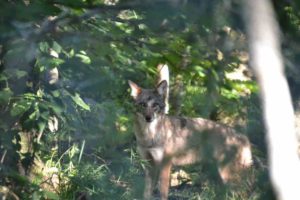
A Lynx lying in the shade of a tree, two very lazy Black bears (especially the male) and two Pumas.
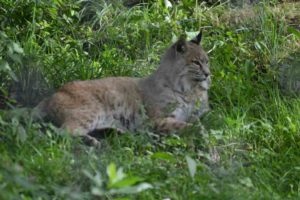
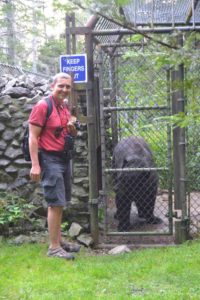
But my favourites were the little guys. The Woodchuck (known to me as a Groundhog… I previously thought Woodchuck was a kind of squirrel), the Tree porcupine, the Raccoons and the, wait for it . . . Beavers : ). The Groundhog was actually quite funny, because they had made a beautiful home for it, but instead it dug itself a very well hidden hole in the far corner. I just love the irony of it ; P.
The Raccoons were very busy and constantly moving. They had lots of toys in their cage. There was a a tire suspended from the wire mesh above a yellow slide in the far back. No matter how much I telepathically willed them to, neither of the two Raccoons went down the slide : (. They were far to interested in us ; ). We offered them one or two treats, and they took them and even ate some of it, but it’s clear that the treats are not the Raccoon’s favourites. Raccoons only look as if they have disposable thumbs, but they’re faking it. Their paws are more like those of a bear, acting as a unit, rather than separate fingers. It’s cute and interesting how they awkwardly maneuver the treats around in their paws, rolling the treats back and forth between their palms to make it rise if they originally gripped it too high.
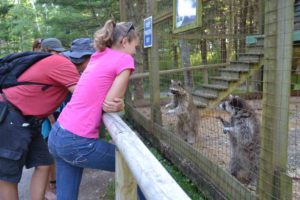
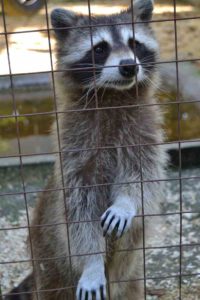
And now the Beavers. I actually don’t know how to describe them. . .Wait, I know. They are like a big chocolate brown Dassie, teeth like that of a Mole and a tail like, uh, like – well, like a Platypus : P. There were two of them in the enclosure. One was demurely doing its own thing on land, and the other lazily swimming in the big sunken tub right next to the fence (sorry enclosure designers, it really does just look like a tub), lazily moving the small sticks about in the water.
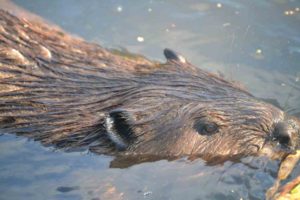
The Beaver did seem to spend more time under the water than above it. Every time the Beaver came swimming past we had a good look at it. The tails look almost wrong on them, because their bodies are covered in thick fur, but the tails are only covered in soft-looking scales. If beavers had not been so well known from the start I’m sure they would have made just as big a sensation as the Platypus. Each Beaver’s tail boasts it’s own selection of niches and scars. When we walked around the park the second time (quickly just before closing time), they were both on land and we gave them a few treats. They obliterated these in about three bites. Those treats were hard! I’m pretty sure all South Africans have eaten at least one rusk without dunking it in tea or coffee first. Hard work right? Imagine what jaw power and strong teeth it would take to bite through the rusk in just a couple of bites and with no apparent effort or loss of time. . . Well, we certainly gained a lot of respect for Beavers and it has now properly sunk in that that these guys are literally capable of chewing down trees. Remember, they are not even very big!
Just as we were starting to go back along the paths to leave after a lovely day, we spied one of those red squirrels climbing into a dustbin next to the path. We weren’t really sure if perhaps the squirrel needed help, because the dustbin had one of those push-in lids and the squirrel could very well be trapped inside. My Dad, Sophia and I went over to the dustbin and he pushed in the lid to see if the squirrel actually was in the dustbin. I don’t know who had the bigger fright…. us or the squirrel! It was just inside the lid, probably on its way out again, and when my Dad disturbed it, it just zoomed past into a tree. It was very funny : )
Our family have a Zoo system that’s working rather well so far. After looking at all the animals and doing the proper path, we go through the Zoo again. The second time only stopping at our favourite animals (like the Beavers) and to see if those hiding earlier had decided to pop up. We usually have less than an hour to complete this circuit (or semi-circle, or zig-zag, depending on whether or not we find shortcuts), before the Zoo closes. So far on our world trip, we have never left a Zoo or other Animal Park without the staff almost shoving us out ; P. The time just before the Zoo closes is actually the very best time, because it’s exactly when most of the animals are active. I can definitely encourage anyone going to a Zoo to stick around right till closing time and revisit all those animals that were hiding from you earlier the day : ).














1 comment
That is so funny, Franci… Bill and I use the same technique! We also use it in museums and art galleries… quick initial survey then back to our favourites. Works for us as well! 🙂
Thanks for such a well written blog entry. I love reading about all of your adventures.